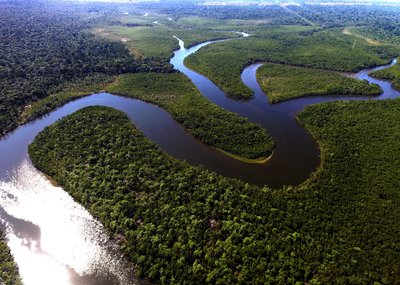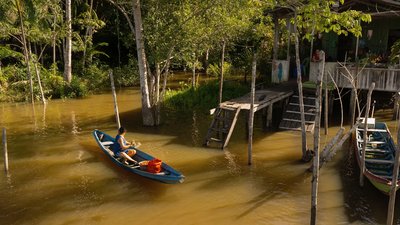
/ Natura &Co Latin America / Climate, biodiversity and nature / Climate Transition Plan
Climate Transition
Plan
Systematizing our climate-related actions
The Climate Transition Plan includes our target for achieving zero net emissions at our own installations (Scopes 1 and 2) and in our value chain (Scope 3)
GRI 201-2, 3-3
- In 2024, supported by regenerative thinking, we created our Climate Transition Plan, made up of the following pillars:
- Build resilience; mitigate climate risks by means of regenerative solutions.
- Achieve decarbonization of the business using science-based targets, aligned with the 1.5° commitment (Paris Agreement).
- Pursue a fair and balanced transition, with comprehensive regeneration for society and nature.
By means of this plan, we are presenting the path and the targets that we have constructed to achieve Net Zero, guided by the Science Based Targets initiative (SBTi). Essentially, this means going beyond the classical mechanisms for offsetting impacts and neutralization, such as the acquisition of carbon credits, to achieve the actual reduction of total greenhouse gas emissions in our operations - both the direct ones, generated by the company itself, and the indirect ones, generated by our value chain (read more on this in the Decarbonization of the Business chapter).
The Climate Transition Plan includes our target for achieving zero net emissions at our own installations (Scopes 1 and 2) by 2030, and in our value chain (Scope 3) by 2050, with an intermediary target of achieving a 42% reduction in the latter case by 2030, as set forth in the Commitment to Life.
It is important to highlight that, until we achieve our targets, we will continue to purchase trustworthy carbon credits at sums equal to our remaining emissions that have yet to be reduced. The choice of the projects for which we purchase credits focused on generating benefits for society, increasing the incomes of the communities involved, and enabling new low carbon technologies and nature-based solutions that can accelerate the transition of the global economy to Net Zero. We are committed to 50% of our credits originating from those communities with which we have partnerships in the Amazon region by 2030 (read more about the Amazon Program later on, starting on page 92).
The carbon market in Brazil
In 2024, the Brazilian Government approved the law that created the Brazilian Greenhouse Gas Emissions Trading System (SBCE).
Since the beginning of the discussions on the creation of a regulated carbon market in Brazil, Natura has been in favor of the fair distribution of the carbon credits amongst the local communities and the inclusion of socio-environmental safeguards in the market mechanisms, in order to ensure environmental integrity and equality in the participation of the interested parties in the mitigation of climate change. For the company, regulation of the market could lead to billion-dollar revenues and create thousands of jobs, improving the public’s quality of life, and allowing the country to position itself as an important global agent in the fight against the climate crisis.
We are partners in alliances aimed at streamlining the paths that will allow society to be Net Zero by 2050. Through our membership in organizations such as the ICC, WBCSD, VCMI, the Global Compact’s Net Zero Ambition Movement, the Brazilian Voluntary Carbon Market Initiative (BR VCM), CEBDS, Commitment to the Climate, and the Brazilian Coalition on Climate, Forest and Agriculture, we aim to give a voice to, and amplify, our position in global forums and in the articulation of public policies and regulations.
Our decarbonization plan
GRI 3-3
We have created six working fronts designed to address the decarbonization of the business: Operations, Formulas, Packaging, Logistics, Magazines and Support Materials, and Non-Cosmetic Products. Together, they account for 75% of the total inventory of Latin America, and 100% of the scope of our SBTi targets. The working fronts are focused on both internal actions and the engagement of suppliers and the value chain, as part of a systemic and holistic approach which is based upon regeneration to reduce and end carbon emissions.
- Operations: focused on actions at our factories, distribution centers and vehicles, implementing more efficient initiatives involving less energy and the elimination of fossil fuels.
- Formulas: we invest in Research and Development to substitute ingredients of mineral origin with those of plant origin, and adopt low carbon regenerative practices throughout the value chain.
- Packaging: we are looking to provide refills, materials which include recycled materials or which originate from a renewable source, use green plastic, and reduce the generation of waste.
- Logistics: the focus lies on increasing the use of renewable and less polluting fuels, and improving the efficiency of the logistics DA network.
- Magazines and Support Materials: we have optimized the portfolio, design and format of our publications, with a reduction in the print run and in the average weight of the magazines, whilst also looking for technological solutions so that, in the future, with the improved usability of digital materials, we can fully end printed materials.
- Non-cosmetic products: just like in Natura’s Crer para Ver line, and Avon’s Home& Style category, we are working to reduce the generation of waste, increase the incorporation of post-consumption recycled plastics and green plastic, and increase the recyclability of the items and the traceability of the supply chains.
In ratio to our Scope 3 emissions, we should highlight the creation of the Regenerative Alliance (read more on this in the ‘Development of Suppliers’ p. 147)), an initiative which brings together Natura and around 100 strategic partners whose contributions are decisive for the success of our climate plan.
our Climate Transition Plan in more detail in the Latin America Databook.

Climate justice
GRI 3-3
Climate justice guides the disproportionate impacts of climate change in different social groups, and is used as a tool for the preservation and protection of the environment and all forms of life, regions and communities.
Climate change is the result of a set of environmental inequalities, meaning that tackling environmental injustice needs to be prioritized with an intersectional vision of gender, race and class issues.
Climate justice means recognizing the disproportionate impacts on traditional, marginalized and Black communities. The perspective of environmental racism is therefore crucial to this discussion.Based upon this context, we have developed a strategy to address climate justice and environmental racism based upon three axes:
- Mitigation and adaptation
We have developed the Socio-climatic Vulnerability Index, to be able to create protocols, and prevention, remediation and adaptation plans. By means of this index, we map the regions at climate risk to be able to identify the vulnerabilities and prevent the threats that could harm our network of relations. - Resilience
To mitigate the impacts and risks that directly affect income, we have been working to reduce the social vulnerability of the network. Furthermore, in 2020, we structured a protocol to provide support in the event of calamities, focused on the wellbeing of the network of Beauty Consultants, employees, suppliers and civil society. We have evolved in this area to be able to act preventively, acting before disaster situations occur. - Education and citizenship
We focus our actions on providing training sessions and communicating about the issue of climate change and climate justice to ensure that our network of relations understands these issues and can begin to act as agents of change and support in their communities.
The Calamity Protocol has already been enacted 20 times since it was created in 2020.
Calamity Committee
GRI 203-1
The Calamity Protocol, structured as a guide for immediate action by Natura in the event of crisis situations has already been enacted 20 times since it was created in 2020. Over the course of the year, it worked in those regions that suffered flooding, in Rio Grande do Sul, and those which suffered record drought levels in the second half of the year. A total of more than BRL 226 million was invested to provide support for the communities in these locations.
In the case of Rio Grande do Sul, where we have relationships with more than 80,000 People, including Beauty Consultants and employees, we offered social, medical and psychological support in the form of telemedicine and a Social Support Center, as well as financial support for the payment of debts and local suppliers. We encourage our employees to volunteer, and we donated five tons of warm clothing and personal hygiene products worth BRL 10 million to the Department of Civil Defense and UNICEF, as well as water and logistics support. We have also created a matchfunding campaign whereby Natura doubles every Brazilian Real donated. By means of this action R$ 900,000 was donated to support the affected people.
Amongst the actions developed to tackle the effects of the droughts in the North, Northeast and Center-West regions, we offered financial support, with the deadlines for payment of debts being postponed and the provision of food and water supplies. As a means of contributing to tackling the depletion of the rivers in the Amazon region, in areas where Natura’s supplier communities operate, we have established activities involving the Ekos Ryos perfumes: for each unit sold, we donate R$ 5.00 to initiatives fighting the effects of the drought. As such, R$ 180,000 was raised, which, once the counter entry from Natura was included, was doubled to BRL 360,000 in funds donated to providing emergency services.
